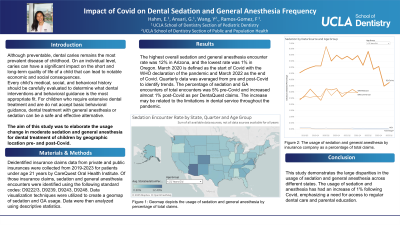Sedation
380 - Impact of Covid on Dental Sedation and General Anesthesia Frequency


Eunice Hahm, DMD (she/her/hers)
Pediatric Dental Resident
University of California - Los Angeles
University of California Los Angeles
Los Angeles, California, United States- GA
Ghassem Ansari, D.D.S., M.Sc., Ph.D., A.P.P.D
Clinical Professor
University of California, Los Angeles
Los Angeles, California, United States
Presenting Author(s)
Program Director(s)
Purpose: The aim of this study was to elaborate the usage change in moderate sedation and general anesthesia for dental treatment of children by geographic location pre and post-Covid.
Methods: Deidentified insurance claims data from private and public insurances were collected from 2019-2023 for patients under age 21 years by CareQuest Oral Health Institute. Of those insurance claims, sedation and general anesthesia encounters were identified using the following standard codes: D9222/3, D9239, D9243, D9248. Data visualization techniques were utilized to create a geomap of sedation and GA usage. Data were then analyzed using descriptive statistics.
Results: The highest overall sedation and general anesthesia encounter rate was 12% in Arizona, and the lowest rate was 1% in Oregon. March 2020 is defined as the start of Covid with the WHO declaration of the pandemic and March 2022 as the end of Covid. Quarterly data was averaged from pre and post-Covid to identify trends. The percentage of sedation and GA encounters of total encounters was 5% pre-Covid and increased almost 1% post-Covid as per DentaQuest claims.The increase may be related to the limitations in dental service throughout the pandemic.
Conclusion: This study demonstrates the large disparities in the usage of sedation and general anesthesia across different states. The usage of sedation and anesthesia has had an increase of 1% following Covid, emphasizing a need for access to regular dental care and parental education.
Identify Supporting Agency and Grant Number:

.jpg)